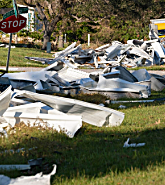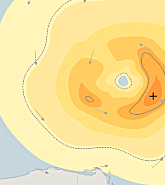The 2014 Atlantic Hurricane Season is already half over, and with only five named storms in the books and El Niño conditions likely by late fall, all signs are pointing to a below-average season.
Over the last six weeks, organizations like Colorado State University (CSU) and the National Oceanic and Atmospheric Administration (NOAA) updated their seasonal outlooks with similar or slightly reduced numbers, attributing them to a variety of oceanic and atmospheric conditions acting to suppress activity, including cooler than normal sea surface temperatures, higher than normal sea level pressures, and stronger than normal wind shear.
Interestingly, the suppressed activity is not being attributed nearly as much to El Niño conditions as originally thought. Despite high likelihoods that the equatorial Pacific would warm to El Niño levels by late summer, observed El Niño Southern Oscillation (ENSO) conditions were neutral during the July and August period, according to the International Research Institute for Climate and Society.
Such observations have certainly impacted ENSO forecasts for the remainder of 2014 into 2015. As of September 4, the likelihood for El Niño conditions to form during the period from September to November dropped to 55% from a convincing 74% probability back in May. Despite this material reduction, most of the ENSO prediction models still forecast the onset of El Niño by early Fall, peaking during Northern Hemisphere winter 2014-2015 and lasting into the first few months of 2015.
Barring any late season surge in activity, this year will be a far cry from the busier seasons of the past, most notably the 2004 season. Like this year, 2004 was also impacted by weak, neutral El Niño conditions. However, the 2004 season was impacted by a rare type of storm known as Modoki El Niño in which unfavorable hurricane conditions are produced in the Pacific instead of the Atlantic Ocean, resulting in above average activity in the Atlantic.
The most notable U.S. hurricanes during the 2004 season were Hurricanes Charley, Frances, Ivan, and Jeanne. These four events damaged an estimated 2 million properties in Florida – approximately one in five houses – and caused more than $20 billion in insured losses throughout the U.S.
The strongest system to hit land that season was Hurricane Charley. The storm made landfall on the southwest coast of Florida on August 13 as a Category 4 hurricane, causing nearly $15 billion in economic damages – one of the most destructive hurricanes in U.S. history.
Just over three weeks later, Hurricane Frances, a large, slow-moving, but less-intense system made landfall on the east coast of Florida as a Category 2 storm with peak winds of 105 mph.
In early September, Hurricane Ivan developed just south of where Frances formed, intensifying quickly. Moving through warm ocean waters, the storm reached Category 5 strength three separate times before making landfall as a Category 3 hurricane along the Mississippi/Alabama border.
When Hurricane Jeanne made landfall in Stuart, Florida on September 26, it marked the second time in history that one state was impacted by four hurricanes in one season.
At this point 10 years ago, nine named storms had already formed in the basin, with six reaching hurricane status. In total, 2004 saw 15 named storms, nine of which became hurricanes, including 6 that reached major hurricane status (Category 3+).
While this hurricane season shares some common characteristics with the 2004 season, so far, 2014 has been relatively quiet while 2004 was the second costliest Atlantic hurricane season in history.






